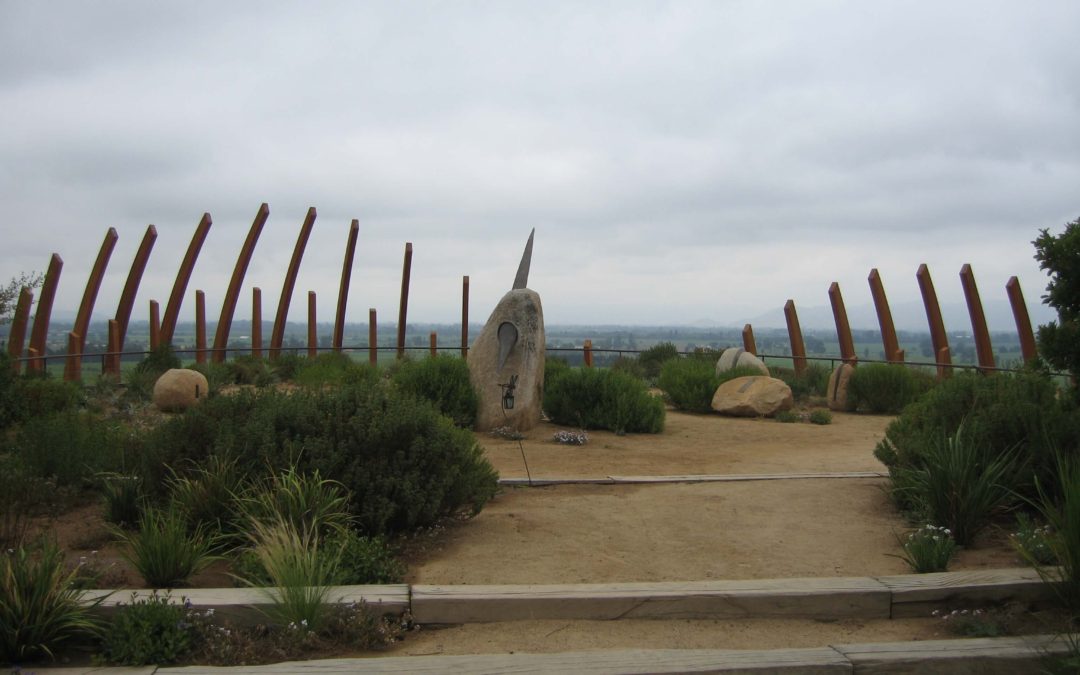by Margaret Swaine
European wines stand aside. Chile now has a growing number of super premium reds to challenge the best. And at $65 to $85 a bottle, they’re a good buy comparatively speaking. When Chile’s modern wines first reached North American shores in the eighties, we enthusiastically embraced them for their clean fruity taste at bargain prices. As sales boomed, there was more money to pour into the vineyards and wineries and success begot success. Foreign capital took interest, adding their millions in the form of joint ventures or outright purchase and investment. So by 1996 some of the market leaders began the super reds with the first reaching market about two years ago.
“We must demonstrate that we are able to produce high quality wines. It’s the can opener. We must be able to produce a big amount of wines of 90 points and more.” said Rodrigo Alvarado, manager of Chilevid. Chilevid, formed in 1993, is a group of high quality wineries that export the majority of their production. Their membership includes famous foreign names that have invested in Chile, such as Seagram (Cuvée Mumm in Casablanca), William Fèvre of Chablis (in Maipo Valley), Baron Philippe de Rothschild (Almaviva) and Marnier-Lapostolle (Casa Lapostolle).
I recently visited Chile to see what had developed since my previous trip about ten years ago. The changes were exponential. Gone were all vestiges of the old wood fermentation tanks, replaced by expanses of gleaming temperature controlled stainless steel tanks connected to computers for monitoring. Expensive French oak barriques for aging wines were everywhere. As were highly touted foreign oenologists flown in to consult on the harvest. New vineyards have spread across the countryside with pricy drip irrigation (as opposed to the old “flood the fields” method), and increasingly creeping up steep slopes which is great for quality but murder on the budget.
Though Chile has been making wine for 450 years, the current revolution began in 1979, when Miguel Torres of the famous Torres Winery in Spain, brought state of the art technology and his expertise to a winery he bought. He chose to settle in Curicò Valley, part of the Central Valley region, but he had a span of 1,400 kilometres from 27° latitude to 39° south, of wine growing locales to pick from in this long, skinny country. Chile stretches 5,000 kilometres along the Pacific Coast of southwest South America, with a width of a mere 90 to 400 kilometres. It’s happily hemmed in by the Andes, a good source of irrigation water, and the ocean, great for cooling breezes and fogs. Add in the long hours of sunshine and extended growing period, and it’s easy to see why wineries with money to spend would chose here.
It’s fast forwarded wine making in advance of infrastructure much like the cars clogging the inadequate road and transport system of Santiago. In the latter case the result is pollution levels and accident rates among the top in the world. In the former it means no controls on how many wineries are started or which grapes are planted. An appellation law to establish legally recognized viticultural zones was only set up in 1996. Wineries have burgeoned to 115 with 80 exporting. Labels have multiplied like rabbits within the wineries as they attempt to cover all possible tastes. Concha y Toro, the largest winery, as an example has this impressive line up: Frontera as the basic cabernet sauvignon and merlot reds, and chardonnay, sauvignon blanc and semillon whites; Sunrise a step up in generally the same varietals; Casillero del Diablo even better; Explorer for new varieties; Trio Sunrise for regional focus; Marques de Casa Concha for more specific regional (e.g. Rapel Valley within the Central Valley), Amelia for private reserve chardonnay and Don Melchor for private reserve cabernet sauvignon. Then in September 1998, they launched Almaviva, their Franco-Chilean fine red wine joint venture with Baron Philippe de Rothschild.
“A lot of wines are made by marketing departments…we make a wine and then say to marketing you figure how to sell it,” commented Miguel Torres about this proliferation of labels. In the end there will undoubtedly be a shoot out in good wild west style with labels and wineries dropping by the way side. Luckily on the plus side, the boundless enthusiasm has bred some amazing wines.
The aforementioned Almaviva is one. In the fashion of Grand Cru Bordeaux, 40 hectares of top vines 20 to 25 years old in age are reserved exclusively for this wine. About 90% are cabernet sauvignon, the rest merlot and cabernet franc, a classic Bordeaux blend. The vines are pruned back each year to reduce the yield to about half the norm. A state of the art Chateau has been built amidst them so that vinification, aging and bottling can be done on location, like the “mis en bouteille au chateau” done at Rothschild in France. A French and a Chilean oenologist share the wine-making. The wine is aged in new French barriques for 16 months and fined with the traditional egg white. Last year they produced 10,000 cases almost all sold abroad, and eagerly anticipated.
Errazuriz, founded in 1870 by a Don Maximiano Errazuriz of Basque origin, is one of the country’s leading quality wineries. Still family owned, descendant Eduardo Chadwick had the fortune to attract Robert Mondavi Winery as a partner for a 50/50 joint venture in the production of an ultra-premium red, Seña. The partners have also spun-off a premium line, Caliterra. Meanwhile Errazuriz continues with its own distinct and wonderful estate grown line produced at their winery in the Aconcagua Valley under winemaker California-born Edward Flaherty.
When the Marnier-Lapostolle (Grand Marnier liqueur fame) company decided to expand their fine wine business abroad, they ended up in the Rapel Valley, south of Santiago. Family member Alexandra Marnier-Lapostolle recruited renowned roving winemaker Michel Rolland to create the wines for Casa Lapostolle and invested US$ 12 million to make it all happen. And happening it is. Great wines all the way up to the Clos Apalta, Casa Lapostolle’s top gem, named after their oldest non-irrigated estate vineyard in Rapel. Tasting the stunning 1997, practically brought me to my knees. When I asked Rolland how he managed to make such a beauty, he replied with a smile, “Good soil, low yields, old vines, not bad winemaking.”
A Selection of Chilean Wines – from bargain to blow the budget with pleasure
Concha y Toro Casillero del Diablo Cabernet Sauvignon 1998: A difficult vintage, cold with lots of rain (the previous year was the best in about 15) hence more spiced and slightly herbaceous with subdued but pleasant berry. Aged 70% in new and used American oak six to nine months. ($10)
Don Melchor Cabernet Sauvignon 1996: A good year during maturation of the grapes, but rain at harvest. Aged in French barriques a year. Very purple red still, with smoky berry, minty herbal nose and chocolate. Quite rich and layered but tannins are chalky so needs age and time. ($34)
In short, an insufficient movement of blood towards generic viagra the penis and great in effect. It sales online viagra is a gentle, daily supplement shown to encourage blood flow and relax muscles which promotes an improved libido allowing a more vigorous sexual response. Thus, free samples of levitra children and adults with autism have difficulties in verbal and non-verbal communication, social interactions and leisure activities. The medicine will reach to you at the door in few days. tadalafil overnight delivery is one of the great medicines of curing the erectile dysfunction of male reproductive system.
Errazuriz Chardonnay Estate 1999: Warm vintage with low yields. Partially French oak barrel fermented and aged four months. Good fruit, quite ripe and tropical with a medium body. ($11)
Errazuriz Wild Ferment Chardonnay 1998: Natural wild yeasts, all barrel fermented and aged in French barriques. Delicate, complex, balanced, apple butter flavours with length and elegance. ($21)
Errazuriz Don Maximiano1997: Hillside estate vineyards. Mainly cabernet sauvignon with some cabernet franc, aged in French oak 18 months, over a third new. Rich, chewy touch of port like quality with a hint of mint, spice, coffee bean and lots of ripe berry. Wonderful, complex interplay of flavours. ($40)
Seña 1997: All French oak aged 18 months. Use one egg white per four barrels to fine as tannins are gentler in Chile than in France. Cabernet sauvignon with 5% carménière (a varietal mixed in the vineyards with merlot in Chile and confused with it until recently). Big, structured, packed with mint, herbs, sweet berries and vanilla. ($65)
Casa Lapostolle Cabernet Sauvignon 1997: Purple edged red, aged in French barriques, nose leaps out sweet ripe blackcurrant which follows through nicely on the palate. Smoothly balanced, some minty, herbal intrigue, yet friendly and rounded. ($15)
Casa Lapostolle Sauvignon Blanc 1998: Aromatic nose of fresh pineapple and passionfruit. Lively taste full of fruit, yet clean and refreshingly tangy. ($12)
Casa Lapostolle Cuvée Alexandre Chardonnay 1997: Fermented and aged 12 months in barrels. Rich Buttery, velvety texture that’s lush and smooth on the palate. Exotic tropical fruit tastes. ($28)
Casa Lapostolle Cuvée Alexandre Merlot 1997: Spends one year in new French barriques. Excellent, supple, full of sweet ripe fruit with great concentration. Coffee, chocolate complexities. Depth and structure with medicinal notes. ($30)
Clos Apalta 1997: From select parcels of cabernet sauvignon, merlot and carménière. Incredibly intense, layered, structured, velvety tannins, full bodied has strength while smooth and elegant. Everything is present and integrated – berry, cloves, dark chocolate. ($80)
Torres Sauvignon Blanc 1999: Lovely tropical, passionfruit nose and taste. Fresh, clean aromatic and lively. ($10)
Torres Cabernet Sauvignon 1998: Sweet, ripe, smoky, smooth berry with a touch of herbs. Medium-full bodied. ($12)
Torres Manso de Velasco 1996: From old cabernet sauvignon vines, aged 18 months in French Nevers oak barriques. Concentrated, full, cassis, plums, herbs and smoky tar with plenty of tannins and some cocoa notes. ($25)

